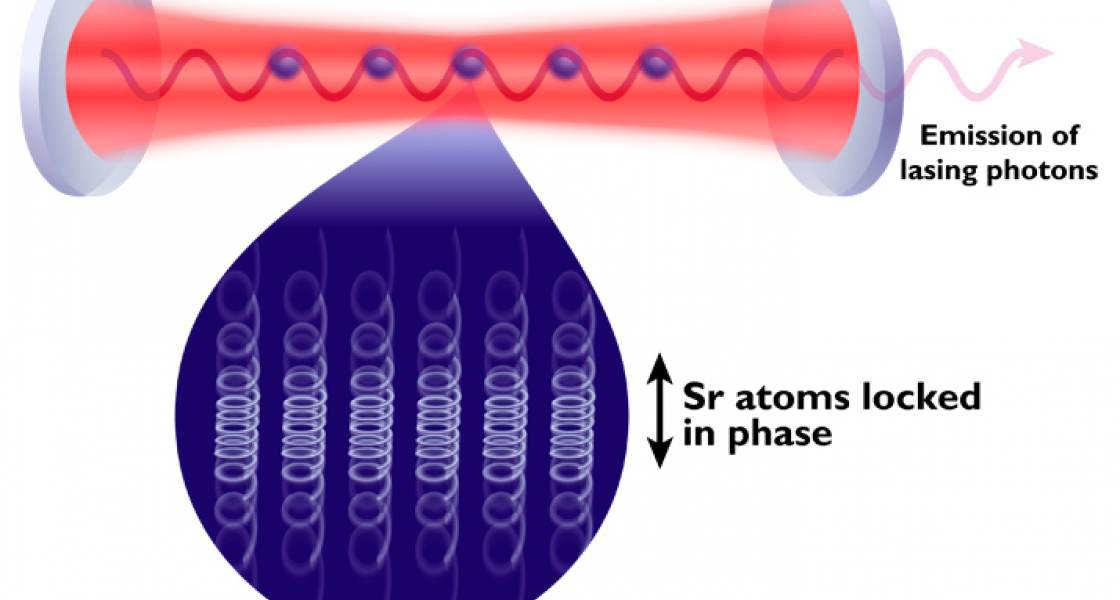To be the best they can be, optical atomic clocks need better clock lasers — lasers that remain phase coherent a hundred times longer than the very best conventional lasers. For instance, light from the clock laser in Fellow Jun Ye’s lab can travel around the Earth 10 times before it loses coherence. However, realizing the potential of the lab’s optical clock requires that the laser light remain coherent for 1000 trips around the Earth. The brute force solution to this problem would be to operate the clock laser at 4 K. This approach would increase the cost, complexity, and size of the optical clock as well as rendering it impractical for space exploration and travel.
Fellow Jun Ye isn’t satisfied with this alternative, so he has enlisted the help of research associate Dominic Meiser, Fellow Murray Holland, and student assistant David Carlson to explore a wild new idea: the use of the clock transition in neutral strontium (Sr) atoms as the basis for an entirely new kind of laser. Meiser, Holland, and Ye have come up with an innovative photonic quantum device that is expected to produce long-lasting phase-coherent light — like a laser. However, the low-power device is based on entirely different principles than a conventional laser. If it works as well in the lab as the theorists predict it will, this laser will be a quantum leap forward in laser technology.
The heart of the new quantum device is a linear chain of neutral Sr atoms inside an optical lattice. These Sr atoms will all dance in the same way exactly in phase when they are connected by a single "lasing" photon running around inside an optical cavity. As the lasing photon travels through the chain of Sr atoms, it "glues" the atoms together and locks them in phase. During this process, all the Sr atoms automatically evolve into a coherent collective superposition of their ground and excited electronic states. This collective superposition causes each atom to oscillate like a spring, but because all the atoms are glued together, the entire chain of atoms extends and contracts in unison, as shown in the figure. This collective "superspring" loses energy by emitting coherent lasing photons, most of which exit the laser cavity.
The collective spring action of the new laser permits the system to emit far more intense coherent radiation than would occur with independent atoms. This collective emission is known as super-radiance. Because the new quantum device is a super-radiant system, its resulting power is about 10-12 W, four orders of magnitude higher than if all the Sr atoms emitted their excess energy one at a time.
This amount of power is critical: Ye believes it is just enough to make it technologically feasible to build the new laser to use with his optical atomic clock. And, that’s really good news. The precision quantum laser will have a frequency linewidth of about a thousandth of a hertz — on the order of, or possibly even narrower than, the Sr lattice clock transition itself! If the laser performs according to expectations, it could improve the stability of the Sr lattice clock by at least a hundredfold.
Plus the laser is compact, relatively simple to build, and practical. It might be just the ticket for measuring picometer distance changes between deep-space satellites in orbit millions of kilometers apart around the Earth. - Julie Phillips



 The Physics Frontiers Centers (PFC) program supports university-based centers and institutes where the collective efforts of a larger group of individuals can enable transformational advances in the most promising research areas. The program is designed to foster major breakthroughs at the intellectual frontiers of physics by providing needed resources such as combinations of talents, skills, disciplines, and/or specialized infrastructure, not usually available to individual investigators or small groups, in an environment in which the collective efforts of the larger group can be shown to be seminal to promoting significant progress in the science and the education of students. PFCs also include creative, substantive activities aimed at enhancing education, broadening participation of traditionally underrepresented groups, and outreach to the scientific community and general public.
The Physics Frontiers Centers (PFC) program supports university-based centers and institutes where the collective efforts of a larger group of individuals can enable transformational advances in the most promising research areas. The program is designed to foster major breakthroughs at the intellectual frontiers of physics by providing needed resources such as combinations of talents, skills, disciplines, and/or specialized infrastructure, not usually available to individual investigators or small groups, in an environment in which the collective efforts of the larger group can be shown to be seminal to promoting significant progress in the science and the education of students. PFCs also include creative, substantive activities aimed at enhancing education, broadening participation of traditionally underrepresented groups, and outreach to the scientific community and general public.